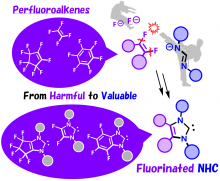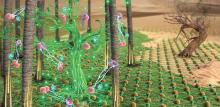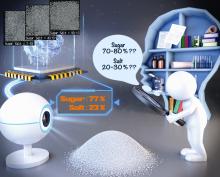Chemistry
News
14 Nov 2023
Lithium-oxygen batteries utilize oxygen in the surrounding air to generate energy. They have shown a high degree of theoretical potential, but the technology has stymied due to the specially designed carbon cathodes lacking certain characteristics. Researchers have made a breakthrough in this regard, developing a special type of porous carbon sheet called graphene mesoponge sheets.
13 Nov 2023
Osaka Metropolitan University researchers have successfully synthesized ligands called fluorinated N-heterocyclic carbenes (NHCs) from environmentally harmful perfluoroalkenes, a type of synthetic chemicals also referred to as PFAS. These NHCs are valuable for stabilizing unstable molecules and enhancing catalytic efficiency. Through further structural modification, these NHCs are expected to find applications in a wide range of substances, including catalysts and light-emitting materials.
06 Nov 2023
They say two heads are better than one. But in the world of fish, it appears two fins are better than one. Researchers have produced a theoretical model that demonstrates the underlying mechanisms behind how fish will synchronize their fin movements to ride each other’s vortices, thereby saving energy.
03 Nov 2023
- A research team led by Professor Jong-min Choi at the Department of Energy Science and Engineering, DGIST, collaborated with a research team of Professor Bum-joon Kim’s research team at the Department of Chemical and Biomolecular Engineering, KAIST, to develop bipolar polymers, which can improve the efficiency and stability of perovskite solar cells
- Developed a process that can repair defects and maximize multifunctionality with the double introduction of bipolar polymers
27 Oct 2023
A research team at Osaka Metropolitan University has developed a new simulation method that accurately predicts powder mixing using AI, and has succeeded in increasing calculation speed by approximately 350 times while maintaining the same level of accuracy as conventional methods. This method is expected to not only pave the way for more efficient and precise powder mixing processes but also open up new possibilities for industries seeking to enhance product quality and streamline production.
27 Oct 2023
- A research team led by Professor Jong-min Choi at the Department of Energy Science and Engineering, DGIST, has successfully developed stable quantum dot thin films, which can improve efficiency and stability in perovskite quantum dot solar cells.
- Suggests a new quantum dot surface stabilization strategy based on a non-polar solvent and covalent ligands
27 Oct 2023
- This team developed the PAINT technology that controls the adhesive properties of new organic materials, analyzes melanin formation processes, and facilitates selective melanin formation.
- A research paper on the technology, which fabricates local patterns based on melanin-like pigments, was published in Nature Communications, an international academic journal.
24 Oct 2023
Layered lithium cobalt oxide, a key component of lithium-ion batteries, has been synthesized at temperatures as low as 300°C and durations as short as 30 minutes.

20 Oct 2023
A huge step forward in the evolution of perovskite solar cells recorded by researchers at City University of Hong Kong (CityU) will have significant implications for renewable energy development.
The CityU innovation paves the way for commercialising perovskite solar cells, bringing us closer to an energy-efficient future powered by sustainable sources.
20 Oct 2023
A research team from Osaka Metropolitan University has found that polysulfides are abundant in broccoli sprouts. They found that the amount of polysulfides increased dramatically during growth, by an approximately 20-fold in seeds by the fifth day of germination. Furthermore, a comprehensive analysis of the polysulfides detected a number of polysulfide candidates whose structures have not yet been determined. The identification of these unknown polysulfides and detailed analysis of their pharmacological activities are expected to enable the development of new preventive and therapeutic strategies and medicines for cancer, neurodegenerative diseases, stroke, inflammation, and other diseases.
16 Oct 2023
Scientists have theoretically predicted that light can be bent under pseudogravity. A recent study by researchers using photonic crystals has demonstrated this phenomenon. This breakthrough has significant implications for optics, materials science, and the development of 6G communications.
16 Oct 2023
The latest ‘large language model’ artificial intelligence system, GPT-4, could aid chemistry researchers, but limitations reveal the need for improvements.

12 Oct 2023
Chemotherapy for cancer treatment often results in collateral damage to healthy cells and other adverse effects. A research team led by City University of Hong Kong (CityU) recently developed “sono-sensitised chemotherapy” (SSCT), a new form of ultrasound-activated chemotherapy, which further enhances the precision for eradicating deeper tumours with centimetre range of tissue penetration and minimises side effects.
12 Oct 2023
Researchers from the Institute of Industrial Science, The University of Tokyo, synthesize a two-center zinc complex that absorbs visible light as a solid and in solution.
03 Oct 2023
Friction, an everyday phenomenon, has perplexed scientists for centuries. Though extensively researched, our understanding remains fragmented, primarily due to the multifaceted interactions that span across varying scales. Achieving an accurate grasp of the precise contact conditions between objects has been a longstanding challenge, a
feat recently made possible through advancements in scanning probe microscopy.
29 Sep 2023
The behavior of electrons in liquids is crucial to understanding many chemical processes that occur in our world. Using advanced lasers that operate at the attosecond, a team of international researchers has revealed further insights into how electrons behave in liquids.
29 Sep 2023
Researchers at Osaka Metropolitan University have succeeded in printing uniformly sized droplets with a diameter of approximately 100 µm using a liquid film of fluorescent ink. This ink, with a viscosity roughly 100 times that of water, was irradiated with an optical vortex, resulting in prints of exceptional positional accuracy at the micrometer scale.
29 Sep 2023
Concave, umbrella-like metal complexes provide space to enable the largest molecular rotor operational in the solid-state.
26 Sep 2023
An international group of researchers have proposed a new mechanism to enhance short-wavelength light (100-300 nm) by second harmonic generation (SHG) in a two-dimensional, thin material composed entirely of commonplace elements.
21 Sep 2023
A group of researchers have unraveled the mysteries behind a recently identified material—zirconium nitride (ZrN) —that helps power clean energy reactions. Their proposed framework will help future designs for transition metal nitrides, paving a path for generating cleaner energy.
21 Sep 2023
A recent discovery in spintronics could potentially transform future electronics. A group of researchers have revealed the key role of cobalt-tin-sulfur in reducing energy consumption, unlocking new possibilities for high-speed, low-power spintronic devices.
20 Sep 2023
A team led by researchers at SANKEN (The Institute of Scientific and Industrial Research), at Osaka University has used neutron crystallography to image all of the atoms in a radical intermediate of a copper amine oxidase enzyme. They disclosed previously unknown details, such as precise conformational changes, that help to explain the enzyme's biochemistry. This work might help researchers engineer enzymes that facilitate unusual chemistry or are highly efficient at room temperature that are useful in chemical industry.
15 Sep 2023
- Research team led by Professor Hongkyung Lee at DGIST developed a manufacturing process for high-quality thin film lithium cathode based on electroplating that can replace commercial lithium foil
- Expected to improve battery life and replace existing lithium foil due to simple size enlargement
15 Sep 2023
- DGIST-ETRI joint research team developed high-energy-density, high-stability all-solid-state battery electrode by applying the prelithiation technology to graphite-silicon electrodes
- Selected as the back cover study by “Advanced Energy Materials,” the best international academic journal in energy
14 Sep 2023
Lab-based studies reveal how carbon atoms diffuse on the surface of interstellar ice grains to form complex organic compounds, crucial to reveal the chemical complexity in the universe.
14 Sep 2023
- Team led by Professor In Soo-Il at DGIST develops a titanium dioxide photocatalyst with enhanced optical and electrical properties utilizing silver and ruthenium
- 135-fold increase in methane production compared to conventional TiO2 photocatalysts (95% selectivity proven)
11 Sep 2023
Researchers at Osaka Metropolitan University have developed a measurement technique that rapidly measures the number of viable bacteria in food products. They have succeeded in drastically reducing the inspection time from 2 days to about 1 hour. With this technology, it will be possible to confirm food safety before shipment from factories and prevent food poisoning.
08 Sep 2023
Capturing carbon dioxide, Shells go nuclear, Worms surf electric fields, Brain repair & Creating matter from light. Plus from our blog: Monitoring research for further impact. Read all in the latest Editor's Choice.
06 Sep 2023
Researchers scientists have unlocked a new realm of possibilities for non-volatile phase change memory, a type of electronic memory capable of retaining data even without power. Traditionally, researchers have relied on chalcogenides, materials with reversible electrical properties during transitions between crystalline and amorphous states. But an exciting alternative has emerged in the form of layered nickelates, complex oxide materials composed of nickel ions. These nickelates, with their unique layered structure and thermally reversible switching of room-temperature electrical resistivity, offer superior performance and sustainability potential.
29 Aug 2023
Machine learning model provides quick method for determining the composition of solid chemical mixtures using only photographs of the sample.
Events
Sorry, nothing coming up for this discipline
Researchers
Sorry, nothing coming up for this discipline
Giants in history
Sorry, nothing coming up for this discipline





























